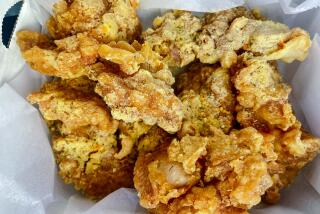Chicken, Pressure Cookers
- Share via
Question: A Times article about fast-food restaurants written by L. N. Halliburton stated that one of the establishments pressure-cooked their chicken in oil, thus imparting a fried flavor. Can you advise me about the safety of such a cooking practice in a home? I do use the pressure cooker but only with water.
Answer: The Chicken Factory, Torrance and Manhattan Beach, prepares their broasted chicken in this manner, but they use specially designed equipment. Do not attempt to duplicate this cooking method with a home pressure cooker. As Halliburton said, with the commercial equipment “a buzzer goes off and the oil is ‘sucked out’ ” of the machine. This is not possible to do in the home.
We repeat, do not use this method to cook chicken in a home pressure cooker.
Q: Of all the sliced cheese in packages, only American cheese is labeled “processed.” Does this mean it is chemically processed or not real cheese?
A: The following definitions are from a pamphlet about cheese distributed by the American Dairy Assn. The slices you are questioning are probably pasteurized process cheese.
Natural Cheese--The solid or casein portion of milk (curds) separated from the liquid portion (whey). Coagulation is caused and controlled by the action of rennet or lactic acid or both. It may be mild (aged two to three months), medium (aged up to six months) or sharp (aged more than six months).
Pasteurized Process Cheese--A blend of fresh and aged natural cheeses that have been shredded, mixed with an emulsifier and heated. Pasteurization stops the ripening, allows the cheeses to blend and develop a uniform flavor, body and texture. The blend may consist of one or more varieties of natural cheese and may contain fruits, vegetables or meats.
Pasteurized Process Cheese Food--Prepared like Process Cheese, except it contains less cheese and more nonfat milk or whey solids and water. It has a slightly higher moisture and lower milk-fat content than Process Cheese.
Pasteurized Process Cheese Spread--Made like Process Cheese Food, but contains slightly higher moisture and has lower milk-fat content.
Unripened, Fresh Cheese--Not cured, so normally quite bland with a mild flavor. Cottage cheese is made from pasteurized skimmed milk, has a mild flavor, moist texture and large or small curds. Cream cheese is a mixture of whole cow’s milk and cream that is pasteurized and coagulated by a lactic acid starter, has a mild flavor and buttery texture. Neufachatel cheese is a lower-fat product similar to cream cheese but made from whole cow’s milk.
Q: Some Scandinavian recipes for cake and cookies call for bitter almonds. I have never been able to find such an “animal.” Can you help?
A: In “The Von Welanetz Guide to Ethnic Ingredients” (Warner Books: 1987), authors Diana and Paul Von Welanetz explain that “bitter almonds are grown throughout the Mediterranean. They are toxic in their raw state; their aromatic flavor is the result of an enzyme reaction that also produces prussic acid. They are processed to flavor extracts, amaretto liqueurs and orgeat, a syrup used in beverages. A few are often added to ‘sweet’ almonds in European recipes to obtain a stronger almond flavor, as is the addition of almond extract for the same reason. Even though their toxic effect is destroyed by heat, it is illegal to sell them as an ingredient in the United States.”
They go on to say: “Almond extract, available in every supermarket, approximates the flavor of the bitter almond, but is cloying if used in excess. We often use amaretto liqueur in recipes calling for this flavor.”


